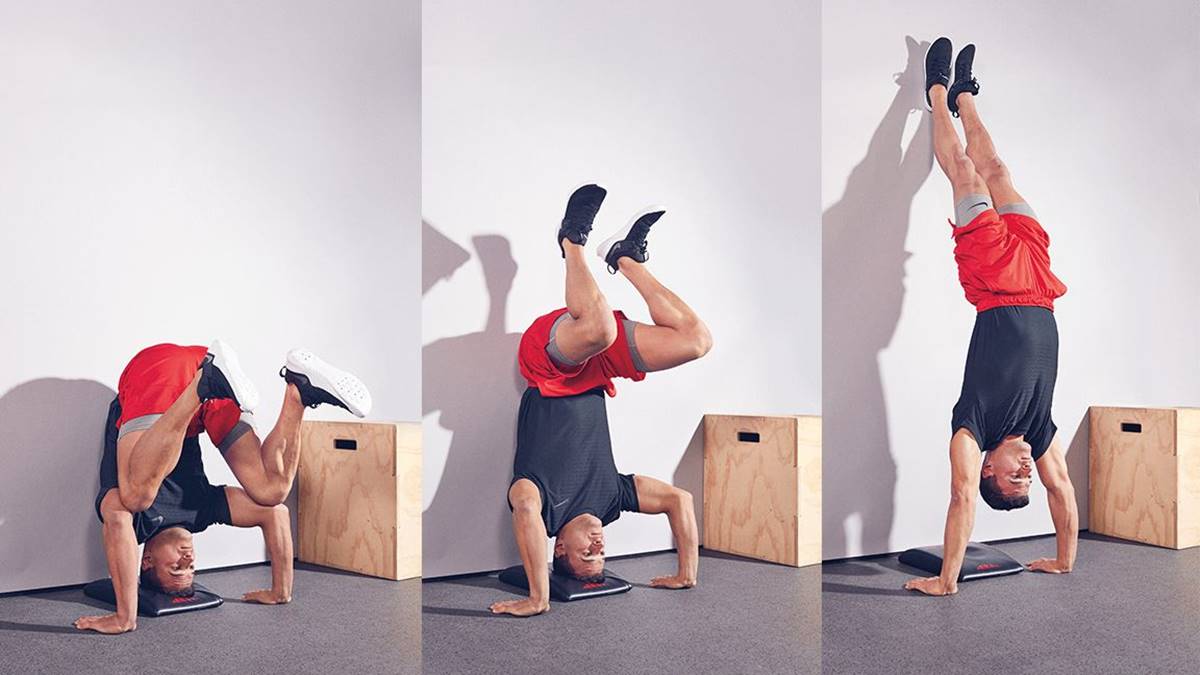

Featured
What Are Reps In A Workout
Modified: January 2, 2024
Discover the importance of reps in your workout routine. This featured guide explains the benefits and proper techniques for maximizing your results.
Introduction
When it comes to working out and building muscle, you may have heard the term “reps” thrown around. But what exactly are reps, and why are they so important in a workout? Reps, short for repetitions, refer to the number of times you perform a specific exercise or movement. Understanding how reps work and their significance can greatly impact the effectiveness of your workouts and help you achieve your fitness goals.
Reps are a fundamental aspect of any workout routine, whether you’re a beginner or an experienced fitness enthusiast. They determine the amount of resistance you place on your muscles and play a crucial role in muscle building and strength development. By manipulating the number of reps you perform, you can target different muscle groups, stimulate muscle growth, improve endurance, and completely transform your physique.
In this article, we will delve deeper into the world of reps and explore why they are essential in a workout. We’ll discuss how to determine the right number of reps for your fitness level and goals, highlight the benefits of performing the correct number of reps, identify common mistakes to avoid, and demonstrate how to adjust your reps as you progress in your fitness journey.
Whether you’re looking to build muscle, increase strength, improve endurance, or simply maintain a healthy lifestyle, understanding reps and incorporating them into your workout routine is essential for achieving optimal results. So let’s dive in and unlock the secrets behind the power of reps in transforming your body.
Definition of Reps
Reps, short for repetitions, refer to the number of times you perform a specific exercise or movement before taking a rest. It is a unit of measurement used in the fitness world to quantify the intensity and workload of a workout. For example, if you perform 10 reps of squats, it means you are executing the squat exercise 10 times consecutively.
Reps are typically paired with sets, which are a predetermined number of cycles of repetitions. For instance, if you perform three sets of 10 reps of bicep curls, it means you complete 10 reps of bicep curls, then rest, and repeat this cycle for a total of three times.
The number of reps you perform during a workout can vary depending on various factors, such as your fitness level, goals, and the specific exercise being performed. Different exercises and fitness goals may require different rep ranges to maximize effectiveness.
It’s important to note that the number of reps alone doesn’t determine the overall effectiveness of a workout. Other variables, such as the weight or resistance used, the tempo of the movement, and the rest periods between sets, all play a role in shaping the outcome of your training session.
By understanding and implementing the concept of reps in your workout routine, you can control the intensity, volume, and progression of your exercises. Whether you’re focusing on muscle building, strength training, or endurance, manipulating the number of reps is a key factor in achieving your desired fitness outcomes.
Importance of Reps in a Workout
Reps play a crucial role in determining the effectiveness of your workout and achieving your fitness goals. Here are some key reasons why reps are important in a workout:
- Muscle Growth and Strength: Performing the right number of reps within a specific weight range can stimulate muscle growth and increase strength. When you perform exercises with resistance, such as weightlifting, the muscle fibers are broken down. Through the process of recovery and repair, the muscles adapt and become stronger, resulting in increased muscle mass and improved strength.
- Targeted Muscle Engagement: Different rep ranges can target specific muscle fibers and engagement levels. Lower reps with heavier weights focus on developing maximal strength and power, while higher reps with lighter weights target muscular endurance. By altering the number of reps, you can emphasize different muscle groups and achieve a well-rounded workout.
- Endurance and Stamina: Performing a higher number of reps with lower weights increases muscular endurance and stamina. This is especially important for athletes or individuals participating in activities that require prolonged physical exertion, such as running, cycling, or sports.
- Metabolic Effects: The number of reps you perform can impact the metabolic response of your body. Higher rep ranges with shorter rest periods increase the metabolic demand, resulting in a greater calorie burn during and after the workout. This can aid in weight loss and improving overall body composition.
- Progression and Tracking: By tracking your reps, you can measure your progress over time. Increasing the number of reps or progressing to heavier weights signifies strength and muscle growth. Consistently challenging yourself by gradually increasing reps helps prevent plateaus and ensures continued progress and improvement.
- Form and Technique: Working within a specific rep range allows you to focus on maintaining proper form and technique throughout the exercise. This not only maximizes the effectiveness of the movement but also reduces the risk of injury.
Understanding the importance of reps in a workout empowers you to tailor your training routine based on your specific goals and needs. Whether you’re striving for muscle growth, increased strength, endurance, or overall fitness, incorporating the appropriate number of reps into your exercises is essential for achieving the desired outcomes.
How to Determine the Right Number of Reps
Determining the right number of reps for your workouts requires consideration of your fitness level, goals, and the specific exercise. Here are some factors to consider when determining your rep range:
- Fitness Level: Beginners may start with a higher rep range to master proper technique and build endurance. As you progress, you can gradually increase the intensity by lowering the number of reps and increasing the resistance.
- Goals: Consider your fitness goals. If you’re aiming for muscle growth and strength, a lower rep range (around 6-8 reps) with heavier weights is more suitable. For muscular endurance and toning, higher rep ranges (around 12-15 reps) with lighter weights may be more effective.
- Exercise Type: Different exercises may require different rep ranges. Compound exercises that engage multiple muscle groups, such as squats or deadlifts, typically benefit from lower rep ranges. Isolation exercises that target specific muscles, like bicep curls or tricep extensions, may benefit from higher rep ranges.
- Rest Periods: Rest periods between sets can also influence your rep range. Longer rest periods allow for heavier weights and lower reps, while shorter rest periods promote higher reps with less weight. Adjust your rest periods accordingly to align with your intended rep range.
- Listen to your Body: Pay attention to your body’s response during a workout. If the weight feels too light and you can easily complete the desired number of reps, consider increasing the resistance. Conversely, if the weight feels too heavy and you are struggling to complete the rep range with proper form, adjust to a slightly lighter weight.
It’s important to note that there is no one-size-fits-all approach to determining the right number of reps. Experimentation and personalization are key. Keep in mind that progress and adaptation are gradual, so be patient and listen to your body’s feedback.
Consulting with a fitness professional or personal trainer can also provide valuable guidance in determining the right rep range for your specific goals and needs. They can assess your fitness level, provide expert recommendations, and design a workout program tailored to your objectives.
Incorporating the appropriate number of reps into your workouts ensures that you are challenging your muscles effectively and progressing towards your fitness goals.
Benefits of Performing the Correct Number of Reps
Performing the correct number of reps in your workouts can have numerous benefits for your overall fitness and well-being. Here are some key advantages of doing so:
- Muscle Growth and Strength: Performing the appropriate number of reps within the recommended weight range stimulates muscle growth and increases strength. This is achieved by challenging the muscles with sufficient resistance, leading to muscle fiber breakdown and subsequent repair and growth.
- Improved Muscular Endurance: Higher rep ranges, typically in the range of 12-15 reps, help improve muscular endurance. This allows your muscles to exert effort over a longer period of time, enhancing your ability to perform activities with less fatigue.
- Enhanced Power and Explosiveness: Lower rep ranges, around 1-6 reps, with heavier weights focus on developing maximal strength and power. This can benefit athletes involved in sports that require explosive movements, such as sprinting, jumping, or throwing.
- Increased Metabolism: Performing the correct number of reps with appropriate weights and shorter rest periods can increase the metabolic demand during and after the workout. This leads to a greater calorie burn, promoting weight loss and improving body composition.
- Improved Form and Technique: By focusing on the correct number of reps, you can ensure that you maintain proper form and technique throughout the exercise. This not only maximizes the effectiveness of the movement but also reduces the risk of injury.
- Optimal Muscle Targeting: Different rep ranges target specific muscle fibers and engagement levels. By incorporating a variety of rep ranges into your workouts, you can effectively target different muscle groups and achieve a well-rounded physique.
- Progress Tracking: Tracking the number of reps performed allows you to monitor and measure your progress over time. Increasing the number of reps or progressing to heavier weights indicates strength and muscle growth, helping you stay motivated and achieve your fitness goals.
- Prevention of Plateaus: Varying the rep ranges keeps your muscles challenged and prevents plateaus. Constantly adapting the number of reps stimulates muscle growth and strength gains, ensuring continuous progress in your fitness journey.
By performing the correct number of reps in your workouts, you can maximize the effectiveness of your training sessions, achieve your fitness goals, and enjoy the numerous benefits that come with a well-rounded exercise routine.
Different Rep Ranges for Different Fitness Goals
Choosing the appropriate rep range is crucial for aligning your workouts with your specific fitness goals. Different rep ranges elicit different adaptations in the body, allowing you to target specific aspects of fitness. Here are some common fitness goals and the corresponding rep ranges that are typically recommended:
- Muscle Growth and Strength: To promote muscle growth and increase strength, it is recommended to perform a lower rep range of around 6-8 reps. This rep range enables you to lift heavier weights, placing a significant stimulus on the muscles and promoting muscle fiber hypertrophy.
- Muscular Endurance and Toning: If your goal is to improve muscular endurance and achieve a lean, toned physique, higher rep ranges of around 12-15 reps are beneficial. This rep range primarily targets slow-twitch muscle fibers and helps to increase muscular endurance by improving the muscles’ ability to sustain repeated contractions over an extended period of time.
- Power and Explosiveness: Athletes and individuals involved in sports that require power and explosiveness, such as sprinting or weightlifting, can benefit from lower rep ranges of 1-6 reps. This rep range allows for the use of heavy weights, focusing on developing maximal strength and power in the muscles.
- General Fitness and Weight Loss: For general fitness and weight loss, it is recommended to incorporate a combination of rep ranges. Performing a variety of rep ranges ranging from 8-12 reps can provide a balance of muscle growth, endurance, and calorie burn. This approach helps improve overall fitness and body composition.
- Injury Rehabilitation: Individuals recovering from an injury may require specific rep ranges depending on their rehabilitation program. This can vary greatly depending on the injury and should be tailored by a healthcare professional or physical therapist to ensure safe and effective recovery.
It’s important to remember that these rep ranges are general recommendations and can be adjusted based on individual preferences, fitness level, and exercise selection. Experimentation and adaptation may be necessary to find the rep range that works best for you.
By understanding which rep ranges align with your specific fitness goals, you can design a workout program that optimizes the desired adaptations in the body and brings you closer to achieving your desired results.
Common Mistakes with Repetitions in a Workout
While incorporating reps into your workouts is essential, it’s also important to be mindful of common mistakes that can hinder your progress. Here are some common mistakes to avoid when performing repetitions in a workout:
- Using Incorrect Form: One of the most common mistakes is performing reps with incorrect form. Poor form not only reduces the effectiveness of the exercise but also increases the risk of injury. Always prioritize proper technique and seek guidance from a qualified fitness professional if needed.
- Lifting Too Heavy: Attempting to lift weights that are too heavy can compromise form and increase the risk of injury. Start with a weight that allows you to perform the exercise with proper form and gradually increase the resistance as you become stronger.
- Skipping the Full Range of Motion: Another common mistake is not completing the full range of motion during reps. This limits the engagement of the targeted muscle group and reduces the overall effectiveness of the exercise. Focus on proper form and ensure that you’re moving through the complete range of motion with control.
- Rushing Through Reps: Performing reps too quickly can compromise form and reduce muscular engagement. Instead, focus on performing each rep with controlled and deliberate movements, emphasizing the mind-muscle connection.
- Not Breathing Properly: Neglecting to breathe properly during reps can lead to feelings of fatigue and dizziness. Remember to inhale during the eccentric phase (negative) of the movement and exhale during the concentric phase (positive).
- Ignoring Rest Periods: Rest periods between sets are crucial for muscle recovery and ensuring proper performance on subsequent reps. Avoid shortening or skipping rest periods, as this can compromise your ability to perform exercises with proper form and intensity.
- Not Tracking Progress: Failing to track the number of reps performed or the weight used can hinder your ability to measure progress. Keeping a workout journal or using a fitness tracking app can help you stay accountable and monitor your strength gains over time.
- Overtraining: Doing too many reps without sufficient rest can lead to overtraining. It’s important to give your muscles and connective tissues adequate time to recover and repair. Incorporate rest days into your routine and listen to your body’s signals to avoid overexertion.
Avoiding these common mistakes will help ensure that you’re maximizing the benefits of reps in your workouts and minimizing the risk of injury. Always prioritize quality over quantity, and remember that proper form, controlled movements, and adequate rest are essential for a safe and effective training session.
Adjusting Reps as You Progress
As you progress in your fitness journey, it’s important to adjust your reps to continue challenging your muscles and stimulating further progress. Here are some key considerations for adjusting reps as you advance:
- Increasing Resistance: As you become stronger, it’s essential to gradually increase the resistance by either adding more weight or using more challenging variations of the exercises. This allows you to continue pushing yourself and elicit further muscle adaptation.
- Lowering Rep Range: Once you’ve mastered proper form and developed a solid foundation, you can consider lowering the rep range to enhance strength and muscle development. This may involve decreasing the number of reps per set and focusing on heavier weights.
- Progressive Overload: Incorporate the principle of progressive overload into your workout routine. This involves gradually increasing the demands placed on the muscles by manipulating variables such as intensity, volume, and rep range. This constant progression ensures continued growth and prevents plateaus.
- Varying Rep Ranges: To keep your workouts stimulating and prevent monotony, incorporate different rep ranges into your training program. This not only challenges your muscles from different angles but also provides variety and prevents adaptation. Consider alternating between higher rep ranges for endurance and lower rep ranges for strength.
- Introducing Advanced Techniques: As you become more experienced, you can integrate advanced training techniques such as drop sets, supersets, or negatives. These techniques can further intensify your workouts and push your muscles to new limits.
- Periodization: Implementing periodization in your training plan can optimize your progress. Periodization involves dividing your training into cycles or phases, focusing on different aspects of fitness within each phase. This allows for targeted training and prevents overtraining or stagnation.
- Listen to Your Body: Pay attention to how your body responds to different rep ranges and adjust accordingly. If a particular rep range feels too easy or doesn’t elicit a significant challenge, it may be time to increase the intensity. Conversely, if a rep range feels too demanding and compromises your form, consider reducing the weight or rep range temporarily.
Remember, the key is to continually challenge yourself and push past your comfort zone. By adjusting your reps appropriately as you progress, you’ll ensure that your muscles continue to adapt and grow, propelling you towards your fitness goals.
Conclusion
Reps, or repetitions, are a foundational aspect of any workout routine. Understanding their importance and incorporating the correct number of reps into your exercises can greatly impact the effectiveness of your workouts and help you achieve your fitness goals.
By performing the appropriate number of reps, you can stimulate muscle growth, increase strength, improve muscular endurance, and enhance overall fitness. Different rep ranges target specific muscle fibers and engagement levels, allowing you to tailor your workouts to your specific goals.
It’s essential to avoid common mistakes when performing reps, such as using incorrect form, lifting too heavy, or skipping the full range of motion. By focusing on proper technique and avoiding rushing through reps, you can maximize the benefits of each exercise.
As you progress in your fitness journey, adjusting your reps becomes crucial to continue challenging your muscles. Increasing resistance, lowering the rep range, and introducing advanced training techniques are all effective ways to ensure continuous progress and prevent plateaus.
Remember to listen to your body and make adjustments as needed. Your fitness goals may evolve over time, and your rep ranges should align with those goals. With consistency, dedication, and the right rep ranges, you can transform your body and achieve the results you desire.
Incorporate the power of reps into your workouts, track your progress, and always strive for improvement. Whether you’re aiming for muscle growth, increased strength, endurance, or maintaining overall fitness, the right number of reps can unlock your potential and help you reach new heights in your fitness journey.









